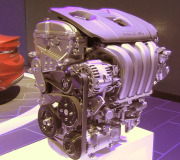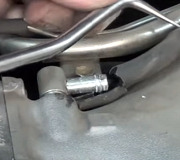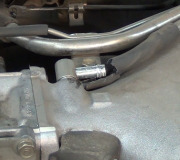In case you haven't figured it out yet, these are dandy little cars. They're really tough too, like ostrich eggs.
For the steering problem something is moving when there's sideways force on the car. The things to look at first are for sideways movement in the lower ball joints, a worn upper strut mount, sloppy struts, a loose rack and pinion assembly, and a worn panhard rod in the rear.
For the ball joints you have to support the car on jack stands under the frame or cross member, not the lower control arm. With the control arm hanging free, grab the tire on top and bottom and try to tip the tire in and out on top. If you can feel a clunk and see the movement have a helper do that while you look underneath. If you see any sideways movement between the ball and stud, replace the ball joint. That movement can be too small to feel so watch while your helper tugs on the tire even if you didn't feel anything. If there's movement in the tire and wheel but not the ball joint, suspect the wheel bearing but they get real noisy long before they get sloppy.
If the ball joints are still original, the small round protrusion the grease fittings are screwed into is a wear indicator. Slide your fingernail along the bottom up to that protrusion. If your fingernail catches on it, the ball joint is okay, at least in that respect. If the protrusion is recessed or the grease fitting is loose and can be wiggled or turned, the ball joint needs to be replaced.
Also check that the ball joints are fully seated in the control arms. If one has dropped down or is sitting in the hole crooked, the control arm can be pried down to seat it properly, then a couple of tack welds with a wire feed welder will hold it there.
For the upper strut mount, those can be hard to diagnose without taking them apart. That's why very often the mechanic has to tell you that new ones are needed when they're replacing the struts. When they get them apart is when they find the wear. What you can try is pushing the large nut sideways while the car is sitting normally on the wheels. You'll have to push hard to make it move. If it does, you need new upper mounts. If you can't get them to move, spray some baking flour around those large nuts then drive the car in a manner to make the problem act up. Check the powder to see if it's scraped away on two sides of one of the nuts. That would prove the strut is moving.
Due to the steering geometry, if the strut moves in or out on top the steering arm moves half as much too but the tie rod ends aren't. Since the relationship between them changes, that causes that wheel to turn left or right a little too. You will see that as a change in the steering wheel position. That can be a hard one to decipher, even for novice alignment mechanics. There's a subtle difference between something shifting causing the steering wheel to change position vs. Something causing the car to go in a direction other than what you intended and you have to correct for that by turning the steering wheel.
A loose rack and pinion assembly will cause the steering wheel to change position but nothing else as far as handling. The front tires tug hard on the steering linkages when accelerating and push on them when braking. A clue here is if you brake hard with one front tire on sand so it doesn't grab as well as the other one, the forces will be uneven and cause the rack to shift. That does not require cornering to show up although it can.
To check for slop in a strut, first look over the tops of the tires at the top of the body where the shaft comes out. That part is easiest when the car is jacked up and the suspension is hanging down. If you see evidence of oil leakage suspect there's more going on than just a bad seal. The strut must be replaced but chances are there's movement between the shaft and body too. That allows the top of the wheel to tip in and out depending on whether you're going straight or cornering. Usually there's a single knock each time it shifts position. Physically checking for this can be a little misleading because you must differentiate between the shaft moving up and down, (which is normal), and moving in and out. If you found no evidence of oil leakage, either there's no sideways movement or it's been going on for so long that the oil is all gone and dried up.
The car must be sitting at normal ride height, (not jacked up), then reach over the top of the tire, push the plastic protective cup up if possible, and reach a finger up on top of the strut body so your fingertip touches the shaft. With your other hand push and pull the top of the tire really hard in and out. It's normal for that corner of the car to move up and down a little, and you'll feel the shaft move up and down, but what you're looking for is if the shaft moves away from your fingertip and moves back. There's a noticeable gap or groove around the shaft, about 1/8". If you force your finger down into that depression it can be easier to feel any sideways movement.
One clue to a shifting strut or mount is it will tend to let the tire tip out on top when cornering and it will tip back in when you straighten out. With a loose rack and pinion assembly you'll usually hear a clunk when it moves, the steering wheel will change position when going straight ahead, and it will stay there until something causes it to change again.
The panhard rod is the bar in the back attached to the axle on one end and the frame on the other end. You'd know it if it was broken although on your car the axle assembly is rather beefy so the effects wouldn't be as noticeable as on most other cars. What I would look for instead is the bolts that attach the bar to the frame and axle. Look for shiny "witness marks" around the bolt heads indicating they've been moving. Also look for reddish-colored rust powder around the bolt holes. That's a sign of a broken bolt or a loose bolt that made the hole oblong.
Look at the two large bolts on each side on the front that the lower control arm pivots on. Check for looseness, stretched-out hole, or reddish rust to indicate the control arm is moving. Also look at the rubber bushings. Pry on the arm to see if you can make it move.
If you haven't found the cause of the problem by now have the steering and suspension systems inspected at a tire and alignment shop. They will also "read" the tire wear patterns for clues. Excessive wear on only one edge of one tire is due to incorrect "camber", one of the three main alignment angles. Both tires can have incorrect camber and wear on one edge but the incorrect setting on one has no effect on tire wear on the other side.
"Toe" is the direction the wheels are steering when the steering wheel is straight ahead. "Total toe" is simply the combination of both tires together. If toe on either wheel or both wheels is incorrect making total toe incorrect, there will be a feather edge on both tires. That's from the tires in effect sliding sideways as you go down the road. Total toe always affects both tires equally, front pair or the rear pair, but the wear patterns can be different if camber on one wheel is also incorrect. Alignment mechanics can find and correct that pretty easily with computerized alignment equipment.
Since we already know something is shifting on your car that affects the steering, it is likely there will be some unusual tire wear to interpret.
Sunday, September 16th, 2012 AT 6:54 AM



